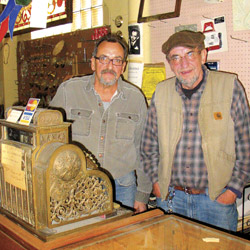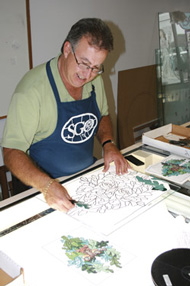On the corner of Monroe and Spring streets sits a 36-year-old product of Peoria, certainly not the first tenant of its aged home. The building’s exterior exudes a sense of authenticity rarely found amidst the modern cityscapes and neighborhoods of today. Everything from the small wooden sign over the door to the old buzzer which loudly announces the arrival of patrons screams “treasure me.” Inside, the atmosphere resembles that of an old hobby shop, where the shopkeepers are personable and really know their stuff—also somewhat rare these days.
What began as a hobby in the home of Jerry McGowan has grown into a flourishing business of artistic craftsmanship. For 36 years, Stained Glass of Peoria has been part of many of the grand creation and restoration jobs in central Illinois. With just three guys—the McGowan brothers, Jerry and Rick, and Cliff Fravell—the company has made a name for itself here in the heartland.
The skill required for stained glass jobs is great, and few can do it well. A quick drive around town will reveal a large number of stained glass windows which adorn churches big and small. Jerry explained that because the average window lasts about 100 years before serious repairs are required—and many churches around here are about that old—there’s plenty of work to keep them busy within their service area, which encompasses a 100-mile radius of Peoria.
A Colorful History
The art of stained glass goes back to ancient times when both Romans and Egyptians excelled at making colored glass. By adding metallic salts or oxides to molten glass, craftsmen found they could create different colors, to be used for goblets, vases and other such items. The Art Glass Association says of colored glass, “It is a jewel-like substance made from the most ordinary materials: sand transformed by fire.” Each metal oxide produces a different colored result: gold makes red glass, cobalt makes blue, silver makes yellow, copper makes green. With the ability to vary each color of glass by changing the amount of oxide added, the art of making the stained glass windows we know today became possible.
In the Gothic period, or about the 12th century, when stained glass windows really became popular, they were used not only for illuminating prominent buildings and elegant castles, but also as what is sometimes referred to as a “poor man’s Bible.” Because the expense of written text was so great at that time, windows depicting Biblical stories were the only way for some to “read” the Good Book. That tradition has continued to this day, with churches lit up by their colorful windows telling Biblical stories from the creation to the apocalypse.
Stained glass windows also became common to tell secular stories or blend in as decorative accents in homes, offices, beauty parlors, and so on. Here in Peoria, one can catch a glimpse of some of the finest stained glass in town by strolling down High and Randolph streets, as well as Moss Avenue. One of the most notable restoration projects took place at the downtown Grand Army of the Republic (G.A.R.) Hall, where a large stained glass window was completely reconstructed from a black-and-white photo of the original.
While stained glass has a rich history, it also has a bright future. As with any industry, advances in technique have been made, allowing the glass wielders of today to produce windows and accent pieces capable of lasting thousands of years. Educational institutions and the Stained Glass Association of America keep the craft alive by teaching traditional skills to students young and old.
 Artisans and Craftsmen
Artisans and Craftsmen
In speaking with Jerry and Rick of Stained Glass of Peoria, it became clear that working with glass is not just an art or a craft, but a combination of the two. One must possess certain artistic skills, as well as those of a craftsman able to turn many small pieces into one cohesive work. Color coordination is necessary even when using a pre-drawn pattern, as is the ability to use intricate tools to cut glass properly. Positioning lines of lead, called cames, between the individual pieces of glass and soldering them together is a technique that must be mastered when making windows and panels. When done correctly, the end result is a piece capable of supporting the weight of the glass.
Between Jerry, Rick and Cliff—who the McGowan brothers call “the real artist here”—Stained Glass of Peoria has kept busy for over three decades restoring antique lamps and existing stained glass windows in homes, churches and public buildings; creating new, custom windows and panels; and teaching workshops and classes through Illinois Central College. “We’ve got more work than we have memory,” Jerry teased. To local artisans, whether professionals or hobbyists, the company sells the supplies needed to craft masterpieces, exemplified by the rows and rows of colored, clear and patterned glass lined up in their shop.
On a tour of the building, we were able to see all sides of the business. The first floor serves as their shop, with a side room devoted to Rick’s collection of antique pool tables. The next stop was the workshop/classroom on the second level. With workbenches set up in a U-formation, the atmosphere is very conducive to teamwork. Rick showed us several of the projects his current students were working on. Even with all different skill levels, from beginner to advanced, he said that most of those who participate in his workshops don’t need much instruction. “Beginners’ instruction is more one-on-one,” he explained, “but it also helps to have them in the same room with those who have been working with stained glass for five years. It helps for them to see that it gets easier when they’re really struggling with cutting the glass, for example.”
Our next stop was the basement studio where the real work is done. Everything from firing glass in kilns to fixing antique lamps to restoring 100-year-old church windows happens right here. We were lucky enough to get to peek into the kiln, which was cooling down from 1,200 to 900 degrees. A piece of green glass—colored to match an antique lamp Rick was fixing—sat on top of a firebrick mold cut to the exact shape and curved to match the rest of the lamp’s pieces.
After seeing Rick and Cliff at work, it’s clear that not only does Stained Glass of Peoria have experience in the art of stained glass, it has true talent. Whether looking for someone to fix a family heirloom or teach you how to do it yourself, the McGowan brothers are a tremendous resource.
If, however, you’re looking for a new accent piece for your front door or you want to add a bit of style to an existing, oddly-shaped window and traditional stained glass is too expensive, a more contemporary, less costly option might be right for you.
Shining a New Light on Things
Bruce Resler of Stained Glass Overlay of Central Illinois showed us his company’s modern-day technique for creating stained glass. With stores nationwide, Resler is one of many Stained Glass Overlay (SGO) artists.
The main difference between traditional stained glass and SGO works is the number of pieces of glass used in each panel or window. Traditionally, several individual pieces of colored glass are held together by lead cames. SGO uses just one large piece of glass, onto which four-millimeter laminate 3M film mylar is overlaid. While lead lines are used in SGO pieces, they are merely decorative lines of lead, not structural cames.
According to Resler, SGO pieces have several benefits. Demonstrating that they’re 65 percent stronger than stained glass, he literally pounded on a window in his shop, much to our surprise. He explained that SGO windows “exceed all parameters of fire codes, stop all ultraviolet light from entering through the glass, and are 40 percent of the weight of old-style stained glass.”
Created on a piece of tempered glass, Resler’s works can be double- and triple-glazed right in his shop at the corner of Glen and Sheridan. Not only that, he has the capacity to design, manufacture and mount custom windows onsite as well.
Resler, who had never worked with stained glass, bought the business from a retired couple just one month after walking in the door and being amazed by what he saw. After apprenticing for five months, Resler quickly learned all aspects of the trade and was comfortable enough to tackle anything his customers threw at him.
Much like traditional stained glass, all of Resler’s SGO pieces begin with a pattern. Unlike the paper patterns used by traditional stained glass wielders, however, Resler uses a computer for this step. After coloring the electronic pattern, Resler emails it to his customer for approval before beginning any other part of the window or panel. After receiving the go-ahead, he hand-cuts each piece of mylar to its exact shape and places it on the  piece of glass, which will be sent through an oven and baked once all colored pieces are in place. A clear sheet of mylar is then placed over the entire piece, which is sent through the oven a second time, strengthening it before it’s delivered to the customer.
piece of glass, which will be sent through an oven and baked once all colored pieces are in place. A clear sheet of mylar is then placed over the entire piece, which is sent through the oven a second time, strengthening it before it’s delivered to the customer.
Resler pointed out that when working on new constructions, there is never a delay for contractors awaiting the arrival and installation that goes hand in hand with traditional stained glass. Because Resler’s overlays go directly on top of existing windows, he can enter the process at any stage—while the glass is still in the manufacturer’s showroom, after it’s installed in the house but before the family arrives, or after the home is completed and everyone’s moved in. The fact that the design is placed on the inside of an existing window and doesn’t change the structure in any way “allows you to keep the integrity of the manufacturer’s glazing without negating the warranty,” Resler noted.
Whether pleased by tradition or intrigued by new technology, you’ll be able to find stained glass that fits your style and budget right here in Peoria. If learning the traditional craft is what you’re after, the talented McGowan brothers at Stained Glass of Peoria are superb resources. If you’re ever in the area, stop by and take a gander at the gems hanging in their shop—they’re sure to amaze! Resler’s Stained Glass Overlay is also full of modern-day beauties. After viewing the numerous windows and panels on display, you’re sure to find it as impressive as we did. a&s


